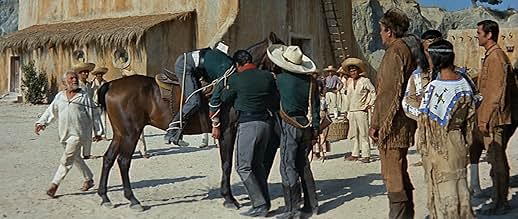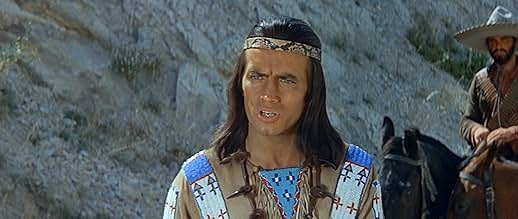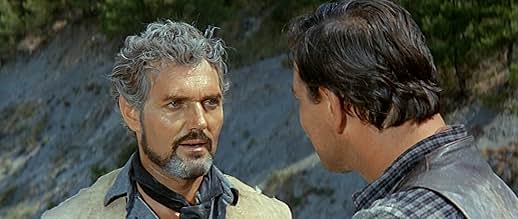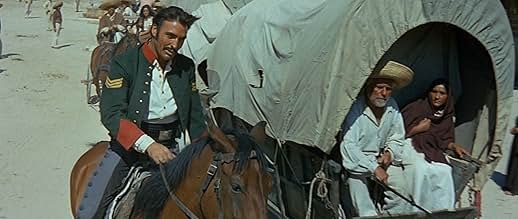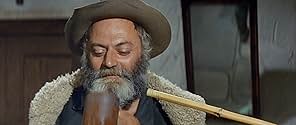NOTE IMDb
5,2/10
1,5 k
MA NOTE
Ajouter une intrigue dans votre langueFirehand and his Apache friend Winnetou are determined to get justice for the murder of four young braves. They set off to track down the gang responsible for the horrendous act.Firehand and his Apache friend Winnetou are determined to get justice for the murder of four young braves. They set off to track down the gang responsible for the horrendous act.Firehand and his Apache friend Winnetou are determined to get justice for the murder of four young braves. They set off to track down the gang responsible for the horrendous act.
- Réalisation
- Scénario
- Casting principal
- Récompenses
- 1 victoire et 2 nominations au total
Jörg Marquardt
- Jace Mercier
- (as Jörg Marquard)
Dusan Antonijevic
- Leon Mercier
- (as Dusko Antonijevic)
Ilija Ivezic
- Moses
- (as Ilija Ivecic)
Aleksandar Belaric
- Hernando
- (non crédité)
Milan Bosiljcic-Beli
- Vince
- (non crédité)
Avis à la une
The brutal Siler gang is on Winnetou's watch list. Four Apaches have recently been killed. Ntscho-Tschi, heavily hurt, barely escaped the murderers. Legendary Old Firehand asks his friend Winnetou for help: Siler's brother is locked up in the prison of Miramonte. If he should not be free soon, Siler threatens to transform the small border town into a sea of flames. Winnetou does not hesitate for a moment to help defend Miramonte with his silver rifle...
The Winnetou westerns are great fun, vibrant, lively and imaginative and action-packed, and this 1966 entry starring Rod Cameron as Old Firehand (old Shatterhand was Lex Barker) and Pierre Brice as Winnetou ticks most of the above, though the earlier Winnetou westerns are stronger, as this one could be a bit talky at times, however it's still quite watchable and has a good cast of characters ( especially the old Englishman as played by Victor De Kova. He lends some good comic relief and he's quite funny and weird.) There's a nice balance between humour and seriousness. The main villain is one cruel dude. The action is lively and well-staged.
The Winnetou westerns are great fun, vibrant, lively and imaginative and action-packed, and this 1966 entry starring Rod Cameron as Old Firehand (old Shatterhand was Lex Barker) and Pierre Brice as Winnetou ticks most of the above, though the earlier Winnetou westerns are stronger, as this one could be a bit talky at times, however it's still quite watchable and has a good cast of characters ( especially the old Englishman as played by Victor De Kova. He lends some good comic relief and he's quite funny and weird.) There's a nice balance between humour and seriousness. The main villain is one cruel dude. The action is lively and well-staged.
There is no question that this film is a wreck. But, like a wreck, it is not without interest. For one thing, the pace is good, the dialogue sometimes odd and not any more clichéd than any other Western of the era, and, happily, unlike too many international Westerns, has an easy plot to follow.
And it has some interesting characters. Most unusual and self-contradictory is the English army man (played by Victor de Kowa), who acts like a highly affectatious Monty-Pythonesque old poof (and he walks really weird), but he wants to marry the boy Jace's mother; bragging like Baron Munchausen, he turns out to actually be a good shot. A difficult character to figure out.
Rod Cameron is not unappealing as the easily-smiling hero; the main attribute of the kid playing his son is that he looks like David Spade. Cameron's main side-kick is the amiably over-weight Vladimir Medov, anticipating Lee Van Cleef's amiable chubby side-kick in "Sabata" by three years.
But Pierre Brice's Winnetao, to me, seems completely out of place; I get that this actor and character starred in a series of films, but his role was a relatively unimportant one here, and it was hard for me to get over Winnatao and his sister romping through the west in leather jump suits and tennis shoes. Ridiculous, actually.
And there are too many flaws of logic to overlook as well. In the first 10 minutes, for example, we are treated to one of the worst cases of "how many bad guys do we have to kill before their number starts to decrease" that I have ever seen. Specifically, in the opening battle, I counted 13 of Silers' men attacking Cameron and the Indians. The good guys kill 9 of them off their horses. 8 of the bad guys ride up to the ledge for closer combat. Two more are shot to death, and 7 ride back after withdrawing. Yikes!
I also scratched my head in confusion in the later sequence in which Silers and Sanchez together first attack the town defended by Cameron. The defenders "trap" them in a ring of fire that looks to be no more than 8 inches high. Terrified, the bad guys retreat. Was the 8 inches of fire that great an obstacle?
On the other hand, the movie treats us to more religious imagery, treated with genuine reverence, than we are wont to see in typical spaghetti Westerns (or any Westerns, for that matter). The scene in which the priest holds up a gold crucifix in the face of the invading outlaws, momentarily stopping them in their tracks, is affecting and oddly pleasing. One image of him, shot from below and in front of him, is very well done, as his arms, holding the cross above his head, frame a perfect Byzantine-style halo around his head. A good moment for the camera-man.
A lost opportunity for a truly horrifying moment was the interesting scene in which a parade of dead peasants in their wagons slowly ride back into town. The director opted here for the suggestion of horror, when I think a more graphic display of the many murdered men sitting upright in the wagons would have been more effective.
This isn't the worst Western by any means, and is odd enough to just perhaps merit your attention for its long 98 minute run-time.
And it has some interesting characters. Most unusual and self-contradictory is the English army man (played by Victor de Kowa), who acts like a highly affectatious Monty-Pythonesque old poof (and he walks really weird), but he wants to marry the boy Jace's mother; bragging like Baron Munchausen, he turns out to actually be a good shot. A difficult character to figure out.
Rod Cameron is not unappealing as the easily-smiling hero; the main attribute of the kid playing his son is that he looks like David Spade. Cameron's main side-kick is the amiably over-weight Vladimir Medov, anticipating Lee Van Cleef's amiable chubby side-kick in "Sabata" by three years.
But Pierre Brice's Winnetao, to me, seems completely out of place; I get that this actor and character starred in a series of films, but his role was a relatively unimportant one here, and it was hard for me to get over Winnatao and his sister romping through the west in leather jump suits and tennis shoes. Ridiculous, actually.
And there are too many flaws of logic to overlook as well. In the first 10 minutes, for example, we are treated to one of the worst cases of "how many bad guys do we have to kill before their number starts to decrease" that I have ever seen. Specifically, in the opening battle, I counted 13 of Silers' men attacking Cameron and the Indians. The good guys kill 9 of them off their horses. 8 of the bad guys ride up to the ledge for closer combat. Two more are shot to death, and 7 ride back after withdrawing. Yikes!
I also scratched my head in confusion in the later sequence in which Silers and Sanchez together first attack the town defended by Cameron. The defenders "trap" them in a ring of fire that looks to be no more than 8 inches high. Terrified, the bad guys retreat. Was the 8 inches of fire that great an obstacle?
On the other hand, the movie treats us to more religious imagery, treated with genuine reverence, than we are wont to see in typical spaghetti Westerns (or any Westerns, for that matter). The scene in which the priest holds up a gold crucifix in the face of the invading outlaws, momentarily stopping them in their tracks, is affecting and oddly pleasing. One image of him, shot from below and in front of him, is very well done, as his arms, holding the cross above his head, frame a perfect Byzantine-style halo around his head. A good moment for the camera-man.
A lost opportunity for a truly horrifying moment was the interesting scene in which a parade of dead peasants in their wagons slowly ride back into town. The director opted here for the suggestion of horror, when I think a more graphic display of the many murdered men sitting upright in the wagons would have been more effective.
This isn't the worst Western by any means, and is odd enough to just perhaps merit your attention for its long 98 minute run-time.
Winnetou (Pierre Brice) on an errand of justice, gets trapped in a town being besieged and destroyed for revenge by a maniac outlaw's gang. Other than that, Winnetou is merely an afterthought among a sprawling plot of the doings of myriad characters, none of whom make much of an impression except for a surprising Todd Armstrong who is more credible here as "Tom" than he was as "Jason" with the Argonauts. Rod Cameron tries hard but has little presence but not much can really be expected when Winnetou, supposedly an Apache, is always got up more like a Cheyenne or Sioux and lives in a "pueblo" like a Navajo. Hollywood Indians are sometimes just as bogus, but European Indians are always bad. One of the "teepees" in the previous film looked like a circus tent.
Winnetou (Pierre Brice) and his sister Nscho-tschi (Marie Versini) meet Old Firehand (Rod Cameron) and protect a Mexican town against bandits. In a time when the popularity of the series faded, even the return of Marie Versini didn't help much. Rod Cameron was the star of a Karl May western for the first and last time. He didn't appeal one tenth as much to the kids as his predecessor Lex Barker as Old Shatterhand had done. The affected manners of Viktor de Kowa as Ravenhurst did not make him another Castlepool (Eddi Aren't in Winnetou II"). Besides, the Mexican setting took the movie one step closer to the cynical spaghetti westerns of the late 60s, far away from the myth-making Silver Lake". Instead of Martin Böttcher, Peter Thomas of Edgar Wallace and Raumpatrouille" fame composed the music, but this is clearly not his preferred genre. Almost nothing turns out right in this movie - mostly forgettable. Winnetou would return one more time for "Valley of Death", nevertheless.
I don't understand these negative reviews. No doubts, "Winnetou and Firehand" isn't very great masterpiece like Sergio Leone's "Once upon time in the West", but it's interesting, dynamic action with very effective battle scenes, with splendid soundtrack by Peter Thomas - one of the greatest music in movies about native Americans '(like Trevor Jone's - "The Last of the mohicans", 1992, and Martin Bottcher's - other Winnetou films). Alfred's Vohrer's direction is energetic. photographs of Croatian landscape is impressive. The cast is professional, characters are well characterized. Especially I like beautiful, romantic brother and sister - Pierre's Brice's Winnetou and Marie Versini's Nscho-tschi, Nadia Gray as Michelle (convincing drama of lonely woman), Harald Leipnitz as fanatic avenger Silers, Aleksander Gavric as Derks. The humor and seriousness are well balanced in this film. It's pleasant to see it. To my mind, one of the best movies about Winnetou.
Le saviez-vous
- Anecdotesalternate US title is "Thunder at the Border"
- GaffesWhen one bad guy shoots another near the end, the sound of gunfire and the reaction of being shot occur before the guy with the gun turns around and makes the shot.
- ConnexionsFollowed by Le trésor de la vallée de la mort (1968)
Meilleurs choix
Connectez-vous pour évaluer et suivre la liste de favoris afin de recevoir des recommandations personnalisées
- How long is Old Firehand?Alimenté par Alexa
Détails
- Date de sortie
- Pays d’origine
- Langues
- Aussi connu sous le nom de
- Massacre à la frontière
- Lieux de tournage
- Sociétés de production
- Voir plus de crédits d'entreprise sur IMDbPro
- Durée1 heure 38 minutes
- Mixage
- Rapport de forme
- 2.35 : 1
Contribuer à cette page
Suggérer une modification ou ajouter du contenu manquant

Lacune principale
By what name was Tonnerre sur la frontière (1966) officially released in India in English?
Répondre

